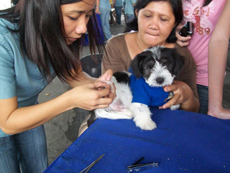Key points
- Pre-exposure prophylaxis vaccination is recommended for people who work directly with animals that could have rabies.
- Those who travel to parts of the world where rabies is common and access to medical care is limited also may consider pre-exposure prophylaxis.

Rabies risks
Most people in the United States have a low risk being around an animal with rabies. However, a small subset of people are at higher risk. This includes those who:
- Work directly with animals that could have rabies
- Travel to parts of the world where rabies is common and access to medical care is limited
These people should receive rabies pre-exposure prophylaxis (PrEP), a series of rabies vaccine doses given before exposure to the rabies virus.
ACIP PrEP recommendations
The Advisory Committee on Immunization Practices (ACIP) rabies PrEP recommendations consist of:
- A two-dose PrEP schedule has replaced the three-dose PrEP schedule to protect people from rabies for up to three years. Options for maintaining protection beyond three years are also described.
- The minimum acceptable laboratory value (antibody titer) used to determine whether rabies vaccine booster doses are needed was revised and standardized.
- Many people for whom serial titers were recommended every two years now require only a one-time titer (and booster if below a certain level) OR a one-time booster.
- Risk categories have been redefined into five risk groups:
Risk category
Who this typically* affects
Recommendations
Risk category 1 Highest risk
People who work with live or concentrated rabies virus in laboratories
- 2 doses, days 0 and 7
- Check titer every 6 months
Risk category 2
People who frequently do at least one of the following: handle bats, have contact with bats, enter high-density bat environments like caves, or perform animal necropsies
- 2 doses, days 0 and 7
- Check titer every 2 years
Risk category 3
People who interact with, or are at higher risk to interact, with mammals other than bats that could be rabid, for a period longer than three years after they receive PrEP.
This group includes:
- Most veterinarians, veterinary technicians, animal control officers, wildlife biologists, rehabilitators, trappers, and spelunkers (cave explorers)
- Certain travelers to regions outside of the United States where rabies in dogs is commonly found
2 doses, days 0 and 7, plus:
- Either a one-time titer check after 1 year and up to 3 years following the first 2-dose vaccination
Or
- 1-dose booster between 3 weeks and 3 years following the first vaccine in the 2-dose vaccination
Risk category 4
Same population as risk category 3, but at a higher risk for ≤ three years after they receive PrEP
2 doses, days 0 and 7
Risk category 5 Lowest risk
General U.S. population
None
Clinical guidance for administering PrEP to people with weakened immune systems has been outlined and includes recommendations to confirm that the vaccine was effective.
*The typical characteristics described may not include the characteristics of all activities that fall within the described risk group.